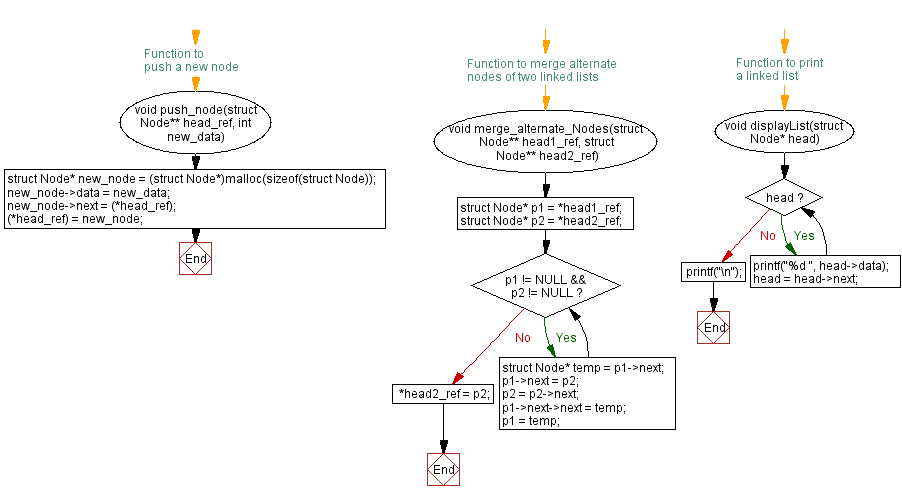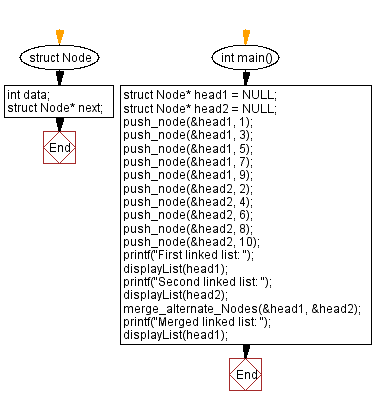C Exercises: Merge alternate nodes of two linked lists
34. Alternate Node Merging Challenges
Write a C program to to merge alternate nodes of two singly linked lists.
Sample Solution:
C Code:
#include<stdio.h>
#include<stdlib.h>
// Structure defining a node in a singly linked list
struct Node {
int data; // Data stored in the node
struct Node* next; // Pointer to the next node
};
// Function to push a new node to the front of the linked list
void push_node(struct Node** head_ref, int new_data) {
struct Node* new_node = (struct Node*)malloc(sizeof(struct Node)); // Allocate memory for a new node
new_node->data = new_data; // Assign data to the new node
new_node->next = (*head_ref); // Make the new node point to the current head
(*head_ref) = new_node; // Update the head to point to the new node
}
// Function to merge alternate nodes of two linked lists
void merge_alternate_Nodes(struct Node** head1_ref, struct Node** head2_ref) {
struct Node* p1 = *head1_ref; // Pointer for the first list
struct Node* p2 = *head2_ref; // Pointer for the second list
while (p1 != NULL && p2 != NULL) {
struct Node* temp = p1->next; // Store the next node of the first list
p1->next = p2; // Make the current node of the first list point to the current node of the second list
p2 = p2->next; // Move to the next node in the second list
p1->next->next = temp; // Make the node from the second list point to the next node of the first list
p1 = temp; // Move to the next node in the first list
}
*head2_ref = p2; // Update the second list's head to the remaining nodes
}
// Function to print a linked list
void displayList(struct Node* head) {
while (head) {
printf("%d ", head->data); // Print the data of the current node
head = head->next; // Move to the next node
}
printf("\n");
}
// Main function to demonstrate merging alternate nodes of two linked lists
int main() {
struct Node* head1 = NULL; // Initialize the first linked list as empty
struct Node* head2 = NULL; // Initialize the second linked list as empty
// Push elements to the first linked list
push_node(&head1, 1);
push_node(&head1, 3);
push_node(&head1, 5);
push_node(&head1, 7);
push_node(&head1, 9);
// Push elements to the second linked list
push_node(&head2, 2);
push_node(&head2, 4);
push_node(&head2, 6);
push_node(&head2, 8);
push_node(&head2, 10);
printf("First linked list: ");
displayList(head1); // Display the first linked list
printf("Second linked list: ");
displayList(head2); // Display the second linked list
merge_alternate_Nodes(&head1, &head2); // Merge alternate nodes of both lists
printf("Merged linked list: ");
displayList(head1); // Display the merged linked list
return 0;
}
Sample Output:
First linked list: 9 7 5 3 1 Second linked list: 10 8 6 4 2 Merged linked list: 9 10 7 8 5 6 3 4 1 2
Flowchart :


For more Practice: Solve these Related Problems:
- Write a C program to merge alternate nodes from two linked lists after reversing the second list.
- Write a C program to merge alternate nodes from two lists, handling cases where the lists are of unequal lengths by appending extra nodes at the end.
- Write a C program to recursively merge alternate nodes from two singly linked lists without using extra memory.
- Write a C program to merge alternate nodes from two linked lists and then swap values for nodes that are out of sorted order.
Go to:
PREV : Alternate Node Deletion Variants.
NEXT : Sorted Duplicate Removal Challenges.
C Programming Code Editor:
Have another way to solve this solution? Contribute your code (and comments) through Disqus.
What is the difficulty level of this exercise?
